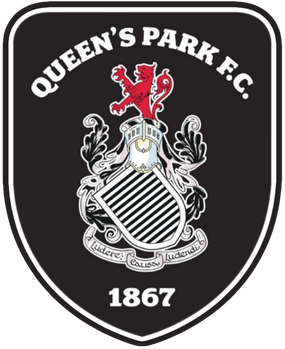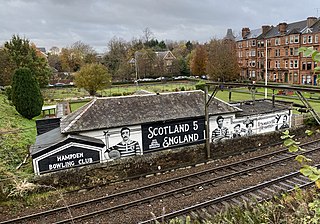
Queen's Park Football Club is a Scottish professional football club based in Glasgow, which currently plays in the Scottish Championship, the second tier of the Scottish football pyramid. Queen's Park is the oldest association football club in Scotland, having been founded in 1867, and is the 10th oldest in the world.

Hampden Park is a football stadium in the Mount Florida area of Glasgow, Scotland, which is the national stadium of football in Scotland and home of the Scotland national football team. It regularly hosts the latter stages of the Scottish Cup and Scottish League Cup and has also been used for music concerts and other sporting events including the 2014 Commonwealth Games.

Third Lanark Athletic Club was a Scottish football club based in Glasgow. Founded in 1872 as an offshoot of the 3rd Lanarkshire Rifle Volunteers, the club was a founder member of the Scottish Football Association (SFA) in 1872 and the Scottish Football League (SFL) in 1890. Third Lanark played in the top division of the SFL for the majority of the club's existence, and won the league championship in 1903–04. The club also won the Scottish Cup twice, in 1889 and 1905. Third Lanark went out of business in 1967, as a result of mismanagement, six years after having finished in third place in the SFL. Third Lanark's former ground, Cathkin Park in Crosshill, is still partially standing and is used for minor league football.
Sport plays an important role in the culture of Glasgow, the largest city in Scotland. Association football is particularly popular: Glasgow is known for the fierce Old Firm rivalry between Scotland's most successful clubs, Celtic and Rangers. The national stadium, Hampden Park, is located in the city and stages most home matches of the Scotland national team, as well as the finals of the Scottish Cup and Scottish League Cup. The Scottish Football Association (SFA) and Scottish Professional Football League (SPFL) are both also based at Hampden. The world's first official international match took place in Glasgow in 1872.

Hampden Park in Glasgow is the primary home stadium for the Scotland national football team. This has been the case since 1906, soon after it opened. The present site of Hampden Park is the third location to bear that name and both the previous locations also hosted Scotland games. Scotland have also played many of their home games in other stadiums throughout their history, both in friendly matches and for competitive tournaments.

Season 1875–76 was the third season of competitive domestic football in Scotland. It also saw the introduction of the international fixture against Wales. In addition, the first regional competition was introduced, with the first playing of the Edinburgh FA Cup, for clubs in Edinburgh and surrounding areas.

The 1873–74 Scottish Cup – officially the Scottish Football Association Challenge Cup – was the first season of Scotland's most prestigious football knockout competition. A total of 16 teams from the west of Scotland entered the competition, however only 14 would play a match after two withdrawals. The competition began with the first match between Renton and Kilmarnock on 18 October 1873 and concluded with the final on 21 March 1874. After 16 matches and 38 goals, the inaugural cup was won by Queen's Park who defeated fellow Glasgow club Clydesdale 2–0 in the final.

The 1874–75 Scottish Cup – officially the Scottish Football Association Challenge Cup – was the second season of Scotland's most prestigious football knockout competition. Teams from Edinburgh, Renfrewshire and Lanarkshire entered the competition for the first time and with 12 new teams entering the competition, a total of 25 were included in the first round draw. The competition began with the first round match between Rangers and Oxford on 10 October 1874 and concluded with the final on 10 April 1875. After 27 matches and 56 goals scored, defending champions Queen's Park retained the trophy by defeating Dunbartonshire club Renton 3–0 at the original Hampden Park.

The 1879–80 Scottish Cup – officially the Scottish Football Association Challenge Cup – was the seventh season of Scotland's most prestigious football knockout competition. With 142 entrants, this season saw the largest number of teams to compete for the trophy since its inception. Three-time defending champions Vale of Leven lost their first match in the competition for four seasons when they were knocked out in the first round, losing 4–3 to rivals Dumbarton. Queen's Park regained the trophy as they won the competition for the fourth time after beating Thornliebank 3–0 in the final on 21 February 1880.

The 1886–87 Scottish Cup was the 14th season of Scotland's most prestigious football knockout competition. Hibernian won the competition for the first time after they beat Dumbarton 2–1 in the final.

The 1888–89 Scottish Cup was the 16th season of Scotland's most prestigious football knockout competition. 3rd Lanark RV beat Glasgow rivals Celtic 2–1 in a replayed final. The original match was won 3–0 by 3rd Lanark RV but the SFA ordered a replay due to the playing conditions.
The 1876 Scottish Cup Final was the third final of the Scottish Cup and the final of the 1875–76 Scottish Cup, the most prestigious knockout football competition in Scotland. The original match took place at Hamilton Crescent on 11 March 1876 and was contested by Queen's Park and 3rd Lanarkshire Rifle Volunteers. The match was the first final to be held at a neutral venue and also the first to require a replay to decide a winner.
Cathkin Park was a football ground in the Crosshill area of Glasgow, Scotland. It was the home ground of Third Lanark from their foundation in 1872 until they moved to New Cathkin Park in 1903. It also hosted Scottish Cup final matches and the Scotland national team.

Hampden Park was a football ground in Glasgow, Scotland. The home ground of Queen's Park from 1873 until 1883, it was the first of three stadiums to bear the same name, and hosted the first-ever Scottish Cup final in 1874.
Ibrox Park was a football ground in Ibrox, Scotland. It was the home ground of Rangers from 1887 until they moved to the adjacent second Ibrox in 1899. The ground staged the Scottish Cup Final four times and also three Scotland international matches.
Toryglen Regional Football Centre is a facility for football in the Toryglen area of Glasgow, Scotland. The complex was completed in 2009 and is situated close to the national stadium, Hampden Park.
Battlefield Football Club, often referred to as The Battlefield, was a 19th-century football club based in Langside, in Glasgow. The club took its name from the site of the Battle of Langside in 1568.
The 1889 Scottish Athletics Championships were the seventh national athletics championships to be held in Scotland. They were held under the auspices of the Scottish Amateur Athletic Association at Hampden Park, Glasgow, on Saturday 22 June 1889. The championship prizes were presented by Mrs M. P. Fraser, wife of the President of the association.
The 1895 Scottish Athletics Championships were the thirteenth national athletics championships to be held in Scotland. They were held under the auspices of the Scottish Amateur Athletic Association at Ibrox Park, Glasgow, on Saturday 22 June 1895.












